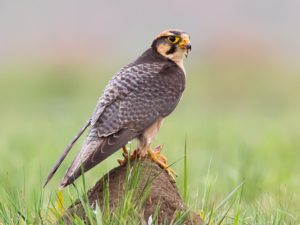Genetic variability and population structuring in the European Lanner Falcon Falco biarmicus feldeggii
Sarà M., Mengoni C., Mucci N., Guzzo E., Ruzic M., Amato M., Antioco N., Boano G., Bondì S., Leonardi G., Nardo A., Mascara R., Ossino A., Vitale E. and Zanca L.
Abstract:
We analysed variation in 10 polymorphic microsatellites and a variable portion of control region of mtDNA in 24 specimens from 3 populations of European Lanner Falcon Falco biarmicus feldeggii living in Sicily, continental Italy and the Balkan area to assess species’ genetic diversity and population structure in the poorly investigated range of this threatened subspecies. We considered also a dataset of previously published mtDNA sequences of the other Lanner Falcon subspecies and of Hierofalco subgenus members (F. cherrug, F. rusticolus and F. jugger) to outline the genetic variation in the region on a wide-ranging basis. Regard with mtDNA we identified 6 haplotypes from our 24 European Lanner Falcon specimens, 3 of which were new and unique (1 Sicilian, 2 Balkans) and the 3 others already known and shared with other Hierofalcons. The 62.5% of our sample, including 14 of Sicilians and one Apulia specimen, belonged to haplotype H_24 shared with F. c. cherrug, F. rusticolus and F. jugger. MtDNA analyses of European Lanner Falcons showed a dispersed pattern of our specimens inside the main Hierofalco clades and haplo- roups in a way congruent to what found in recent literature. These analyses confirmed that none of the Hierofalcons form a monophyletic group, nonetheless the Lanner Falcons can be subdivided in two major Palaearctic (F. b. feldeggii, F. b. erlangeri and F. b. tanypterus) and sub-Sahara African (F. b. biarmicus and F. b. abyssinicus) clades. Microsatellites analysis yielded a first outline of population genetic structure, with genetic identity between continental Italy and Sicily and a moderate degree of differentiation of the Balkan area with Sicily and continental Italy. The 3 populations did not show significant departure from Hardy-Weinberg equilibrium, with low values of the inbreeding coefficients and had allele richness and haplotype diversity consistent with literature. Microsatellites analysis (Nm, frequency of private alleles) suggests a gene flow among the three examined populations and the connection of Sicilian population to those of mainland.
